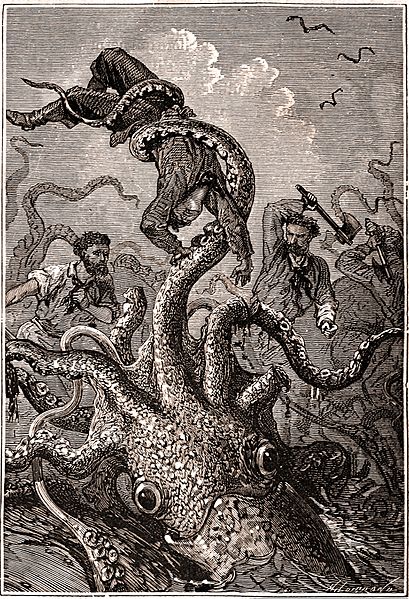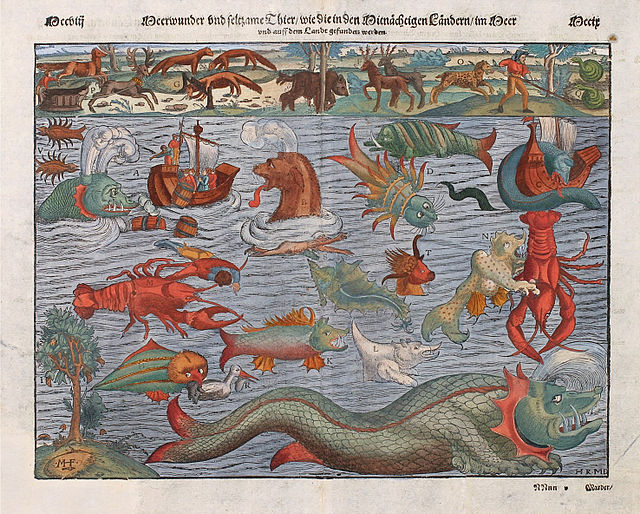The kraken is a legendary sea monster of enormous size, etymologically akin to a squid or octopus, said to appear in the sea between Norway and Iceland. It is believed the legend of the Kraken may have originated from sightings of giant squid, which may grow to 12–15 m in length.
Kraken, an unconfirmed cephalopod. Engraving by W. H. Lizars, in Hamilton, Robert (1839). Naturalist's Library. Adapted "from Denys Montford" [sic.]
A "colossal octopus" that attacked a ship. Drawing by Pierre Denys-Montfort, engraved by Étienne Claude Voysard [fr], 1801
Colorized facsimile – hand-colored woodcut or pen and wash[citation needed]
Old style Scandinavian drag (grapnel anchor) made from the top of a tree, historically known as krake or krabbe in the Scandinavian languages, probably the root for the naming of the mythological monster.
Sea monsters are beings from folklore believed to dwell in the sea and are often imagined to be of immense size. Marine monsters can take many forms, including sea dragons, sea serpents, or tentacled beasts. They can be slimy and scaly and are often pictured threatening ships or spouting jets of water. The definition of a "monster" is subjective; further, some sea monsters may have been based on scientifically accepted creatures, such as whales and types of giant and colossal squid.
Picture taken from a Hetzel copy of Twenty Thousand Leagues Under the Sea.
Plate c. 1544 depicting various sea monsters; compiled from the Carta marina.
Sea serpent reported by Hans Egede, Bishop of Greenland, in 1734
The St. Augustine Monster was a carcass that washed ashore near St. Augustine, Florida in 1896. It was initially postulated to be a gigantic octopus.

![Kraken, an unconfirmed cephalopod. Engraving by W. H. Lizars, in Hamilton, Robert (1839). Naturalist's Library. Adapted "from Denys Montford" [sic.]](https://upload.wikimedia.org/wikipedia/commons/thumb/d/d1/Naturalistslibra25-p326a-kraken.jpg/640px-Naturalistslibra25-p326a-kraken.jpg)
![A "colossal octopus" that attacked a ship. Drawing by Pierre Denys-Montfort, engraved by Étienne Claude Voysard [fr], 1801](https://upload.wikimedia.org/wikipedia/commons/thumb/4/44/Le_Poulpe_Colossal.jpg/371px-Le_Poulpe_Colossal.jpg)
![Colorized facsimile – hand-colored woodcut or pen and wash[citation needed]](https://upload.wikimedia.org/wikipedia/commons/thumb/9/9d/Colossal_octopus_by_Pierre_Denys_de_Montfort.jpg/390px-Colossal_octopus_by_Pierre_Denys_de_Montfort.jpg)




